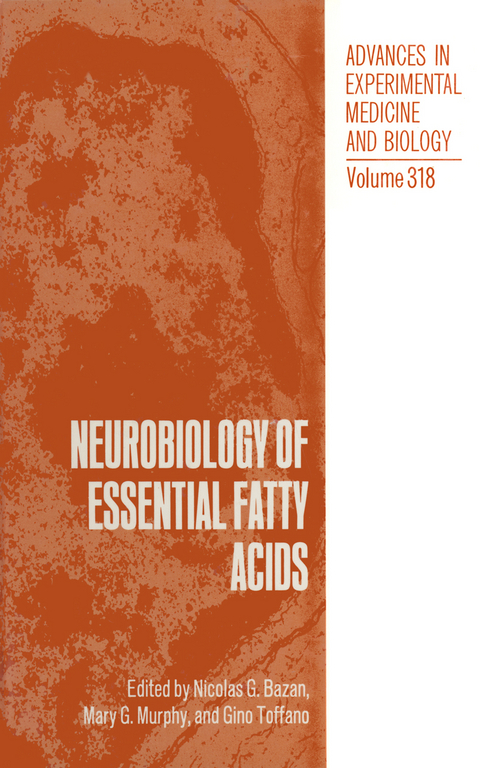
Neurobiology of Essential Fatty Acids
Springer-Verlag New York Inc.
978-1-4613-6515-0 (ISBN)
Phospholipases A2: Properties And Modulation.- The Induction of Cellular Group II Phospholipase A2 By Cytokines And Its Prevention By Dexamethasone.- Brain Phospholipases and Their Role In Signal Transduction.- Characteristics And Possible Functions of Mast Cell Phospholipases A2.- Extracellular Phospholipase A2.- Ischemic Brain Damage: Focus on Lipids and Lipid Mediators.- Cell Signaling and Essential Fatty Acids: Cross-Talk Between Receptors And Messengers.- Reciprocal Regulation of Fatty Acid Release In The Brain by Gaba And Glutamate.- Nmda Receptor-Mediated Arachidonic Acid Release In Neurons: Role In Signal Transduction and Pathological Aspects.- Non-Eicosanoid Functions of Essential Fatty Acids: Regulation of Adenosine-Related Functions In Cultured Neuroblastoma Cells.- Contributions To Arachidonic Acid Release In Mouse Cerebrum By The Phosphoinositide-Phospholipase C And Phospholipase A2 Pathways.- Modulation of Arachidonic Acid Metabolism In Cultured Rat Astroglial Cells by long-chain n-3 fatty acids.- Modulation Of Glutamate Release From Hippocampal Mossy Fiber Nerve Endings By Arachidonic Acid And Eicosanoids.- Metabotropic Glutamate Receptors And Neuronal Toxicity.- Metabolites Of Essential Fatty Acids And Other Membrane-Derived Second Messengers In Cell Signaling.- A role for the arachidonic acid cascade in fast synaptic modulation: ion channels and Transmitter uptake systems as target proteins.- Aplysia californica contains a novel 12-lipoxygenase which generates biologically active products From arachidonic acid.- Essential fatty acid deficiency in cultured sk-n-sh Human neuroblastoma cells.- Phospholipid Metabolism And Second Messenger System After Brain Ischemia.- Dietary Supply Of Essential Fatty Acids, Synaptogenesis, and Photoreceptor Membrane Biogenesis.- Impact of dietary fatty acid balance on membrane Structure and function of neural tissues.- Structural and Functional Importance of Dietary Polyunsaturated Fatty Acids In The Nervous System.- Long and very long polyunsaturated fatty acids of retina and spermatozoa: The whole Complement of polyenoic fatty acid series.- Phospholipid Metabolism In Rat Intestinal Mucosa After Oral Administration of Lysophospholipids.- Carbachol-Stimulated Release of Arachidonic Acid and Eicosanoids From Brain Cortex Synaptoneurosome Lipids of Adult and Aged Rats.- Carbachol-Induced Stimulation Of Inositol Phosphates, Arachidonic Acid and Prostaglandin F2?In Rabbit Retina.- Induced and Spontaneous Seizures In Man Produce Increases In Regional Brain Lipid Detected by In Vivo Proton Magnetic Resonance Spectroscopy.- Network of Signal Transduction Pathways Involving Lipids: Protein Kinase C-Dependent And -Independent Pathways.- Essential Fatty Acids, Excitable Membrane Phospholipids, And Pathophysiology.- Conservation of Docosahexaenoic Acid In The Retina.- Docosahexaenoic Acid Uptake and Metabolism In Photoreceptors: Retinal Conservation By An Efficient Retinal Pigment Epithelial cell-mediated recycling process.- Essential Fatty Acids and Neurodevelopmental Disorder.- Regulation of Arachidonic Acid Metabolism In The Perinatal Brain During Development And Under Ischemic Stress.- Interactions of Phospholipids And Free Fatty Acids With Antidepressant Recognition Binding Sites In Rat Brain.- Very long-chain Fatty Acids in Peroxisomal Disease.- Long Chain Omega 3 Polyunsaturates In Formula-Fed Term Infants.- Severe Changes In Polyunsaturated Fatty Acids In The Brain, Liver, Kidney, and Retina In Patients With Peroxisomal Disorders.- Degradation of Phospholipids And Protein Kinase CActivation For The Control Of Neuronal Functions.- Essential Fatty Acids and Excitable Membrane Phospholipids.- Disposition Kinetics of Phospholipid Liposomes.- Behavioral And Morpho-Functional Correlates of Brain Aging: A Preclinical Study With Phosphatidylserine.- Receptor Coupling To Phosphoinositide Signals.- Diacylglycerol Composition And Metabolism In Peripheral Nerve.- Contributors.
| Reihe/Serie | Advances in Experimental Medicine and Biology ; 318 |
|---|---|
| Zusatzinfo | XI, 444 p. |
| Verlagsort | New York, NY |
| Sprache | englisch |
| Maße | 156 x 244 mm |
| Themenwelt | Medizin / Pharmazie ► Medizinische Fachgebiete ► Pharmakologie / Pharmakotherapie |
| Medizin / Pharmazie ► Pharmazie | |
| Naturwissenschaften ► Biologie ► Biochemie | |
| Naturwissenschaften ► Biologie ► Botanik | |
| Naturwissenschaften ► Biologie ► Zoologie | |
| ISBN-10 | 1-4613-6515-5 / 1461365155 |
| ISBN-13 | 978-1-4613-6515-0 / 9781461365150 |
| Zustand | Neuware |
| Haben Sie eine Frage zum Produkt? |
aus dem Bereich


